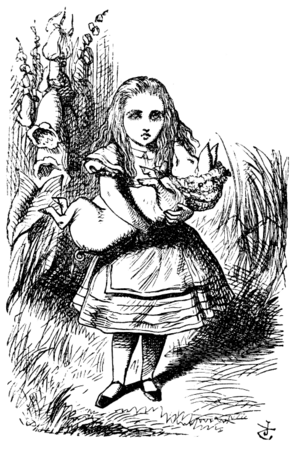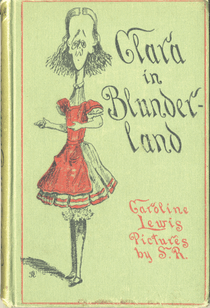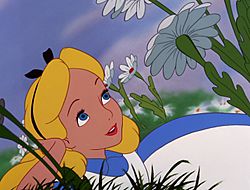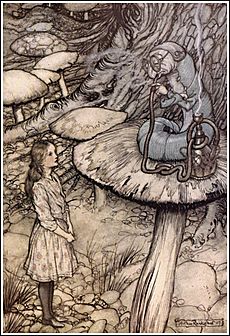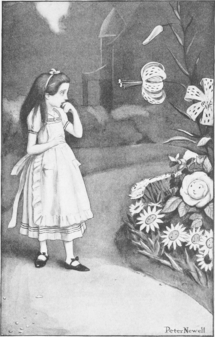Alice (Alice's Adventures in Wonderland) facts for kids
Quick facts for kids Alice |
|
|---|---|
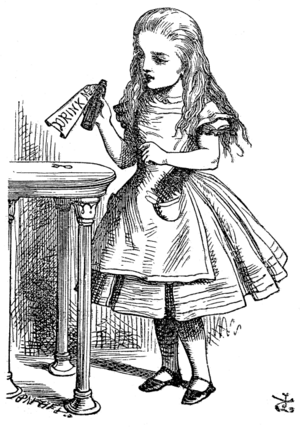
Alice in one of John Tenniel's illustrations for Alice's Adventures in Wonderland
|
|
| First appearance | Alice's Adventures in Wonderland (1865) |
| Last appearance | Through the Looking-Glass (1871) |
| Created by | Lewis Carroll |
Alice is the main character in Lewis Carroll's famous books for kids, Alice's Adventures in Wonderland (1865) and its sequel, Through the Looking-Glass (1871). She is a child living in the mid-Victorian era. In the first book, Alice accidentally falls down a rabbit hole into a magical place called Wonderland. In the second book, she steps through a mirror into another amazing world.
Carroll first told stories about Alice to entertain the Liddell sisters while rowing. Even though Alice shares her name with Alice Liddell, experts aren't sure how much the character was based on the real girl. Carroll described Alice as "loving and gentle," "polite to everyone," "trusting," and "very curious." People often see Alice as clever, well-behaved, and someone who questions rules. However, some think she can sometimes be a bit rude. Her look changed from Carroll's first drawings to the famous pictures by John Tenniel in the books.
Alice has become a very important character in culture. She was different from other child characters in books from the 1800s. The success of her stories led to many other books, funny versions, and copies with similar main characters. Alice has been studied in many ways and has appeared in lots of movies and shows, like Walt Disney's film from 1951. People believe she remains popular because she can be imagined in new ways again and again.
Contents
Who is Alice?
Alice is a made-up child from the middle of the Victorian era. In Alice's Adventures in Wonderland, which happens on May 4th, she is thought to be seven years old. In the second book, which takes place on November 4th, Alice says she is seven and a half.
The author, Lewis Carroll, didn't often describe what Alice looked like in the books. But we can learn some things about her life from the stories. At home, she has an older sister, a brother, a pet cat named Dinah, an old nurse, and a governess. Her governess teaches her lessons starting at nine in the morning. Alice also went to a day school at some point. People have described Alice as belonging to the upper or middle class.
Alice's Personality
In 1887, Carroll wrote that Alice was "loving and gentle." He also said she was "polite to all," "trusting," and "wildly curious." He added that she had "the eager enjoyment of Life that comes only in the happy hours of childhood."
Many people see Alice as innocent, imaginative, and generally well-behaved. They also think she questions grown-ups and is clever. However, some people see less positive sides to Alice. They point out that she can be unkind when talking to the animals in Wonderland. She even kicks Bill the Lizard into the air. These actions might show how she was raised in her society.
Even with her flaws, many readers still admire Alice. They see her as a symbol of control, patience, bravery, and good sense.
Is Alice a Real Person?
It's a bit of a debate whether the character Alice is based on a real person named Alice Liddell. Some critics believe the character is Liddell, or that she inspired Alice. Others argue that Carroll saw his character and Alice Liddell as separate. Carroll himself said that his character was not based on any real child. He said she was completely made up.
Alice's Impact on Culture
Alice is known as a cultural icon. Her books are still printed today, and the first book is available in 100 languages. Alice's Adventures in Wonderland is still very popular. It often appears on lists of top children's books. In a 2015 British survey, Alice was one of the top twenty favorite characters in children's literature. The headband style she wears in Tenniel's drawings is even named after her.
The lasting popularity of the Alice books has led to many movies, new versions of the story, and lots of products. The books started influencing other writers as early as the mid-Victorian era. Many novels copied their style or made fun of political issues using ideas from Alice. These books often had main characters who were polite, spoke well, and were confident, just like Alice.
How People Liked Alice's Books
Alice's Adventures in Wonderland and Through the Looking-Glass were very popular when Carroll was alive. By 1898, more than 150,000 copies of the first book and 100,000 copies of the second had been printed. Readers in Victorian times generally enjoyed the Alice books as fun stories. They liked that the books didn't have the strict lessons often found in other children's books.
The Spectator newspaper called Alice "a charming little girl" with "a delicious style of conversation." The Publisher's Circular praised her as "a simple, loving child." Many reviewers thought that Tenniel's drawings made the books even better.
Later experts have said that Alice's character was unusual for her time. She was different from typical child characters in the mid-1800s. One expert, Richard Kelly, says Alice had to rely on herself in Wonderland. She was away from her family, and her journey was about her mind trying to keep her identity. Another expert, Alison Lurie, argues that Alice didn't fit the idea of a perfect girl from the mid-Victorian era. Alice didn't act as expected and she challenged the adults in Wonderland.
Alice in Movies and Pop Culture
Walt Disney created a very important version of Alice in his 1951 film. This movie helped shape how Alice looks in pop culture. Before Disney, Alice was shown as a blonde in a blue dress in an American book from 1893. But Disney's movie made this look famous. Disney's Alice was inspired by Mary Blair's drawings and Tenniel's pictures.
Today, Alice is still popular because she can be re-imagined in new ways. Catherine Robson wrote that Alice is "the ultimate cultural icon." She can be used for "any and every form of manipulation." Robert Douglass-Fairhurst says Alice is like "a modern myth." She is like an empty canvas where people can put their hopes and fears.
Zoe Jacques and Eugene Giddens say that Alice in a blue dress is as well-known as Hamlet holding a skull. This means people "know" Alice even if they haven't read the books. This allows new movies and shows to be creative and not always stick to the original stories.
Alice in Japan
In Japan, Alice has a big influence on pop culture. Tenniel's artwork and Disney's movie have helped the books stay popular there. In Japanese youth culture, Alice has become a symbol of rebellion. She has also inspired Japanese fashion, especially Lolita fashion. Her popularity is linked to the idea that she represents the shōjo ideal. This is a Japanese idea of girlhood that is "sweet and innocent on the outside, and considerably autonomous on the inside."
Other Artists Who Drew Alice
The two Alice books are often re-illustrated by different artists. When the copyright for Alice's Adventures in Wonderland ended in 1907, eight new versions were printed. One was drawn in an Art Nouveau style by Arthur Rackham. Other artists who drew for the 1907 editions included Charles Robinson and Millicent Sowerby.
Other famous illustrators include:
- Blanche McManus (1896)
- Peter Newell (1901), who used only one color
- Mabel Lucie Atwell (1910)
- Harry Furniss (1926)
- Willy Pogany (1929), who used an Art Deco style
From the 1930s onwards, notable illustrators include:
- Edgar Thurstan (1931)
- Mervyn Peake (1954)
- Ralph Steadman (1967), who won an award for his work
- Salvador Dalí (1969), who used Surrealism
- Peter Blake, with his watercolours (1970)
By 1972, there were 90 illustrators for Alice's Adventures in Wonderland and 21 for Through the Looking-Glass. More recent famous illustrators include:
- Barry Moser (1982)
- Greg Hildebrandt (1990)
- Lisbeth Zwerger (1999), who used watercolours
- Helen Oxenbury (1999), who won two awards for her work
- DeLoss McGraw (2001), with his abstract drawings
Images for kids
See also
 In Spanish: Alicia (Alicia en el país de las maravillas) para niños
In Spanish: Alicia (Alicia en el país de las maravillas) para niños


